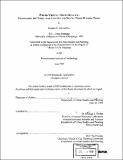Where virtual meets reality : empowering the public with tangible and digital vision building tools
Author(s)
Schweibinz, Stephen E. (Stephen Edward), 1974-
DownloadFull printable version (11.41Mb)
Other Contributors
Massachusetts Institute of Technology. Dept. of Urban Studies and Planning.
Advisor
Michael J. Shiffer.
Terms of use
Metadata
Show full item recordAbstract
Neighborhood community organizations that strive to incorporate the public's ideas into designs and plans have needed more appropriate tools for vision sharing. This thesis described one possible approach for improving the public's ability to design, share, and evaluate alternatives. In the past, the public's primary role during neighborhood design meetings has been that of 'evaluators,' critiquing those designs that were presented to them. This research attempted to illustrate how new and emerging information technology tools could potentially empower the public with the ability to visually express their own design ideas and visions for their neighborhood, shifting the public's role from that of strictly 'evaluators' to that of 'co-constructors.' The strategy presented for vision creation included both a tangible, model-making framework and a digital, virtual reality component. Residents at a public meeting would start the visioning process by 'playing out' their ideas using physical LEGOTM blocks. The intuitive and simple tangible interface of LEGOTM blocks encourages a constructionist approach toward thinking about urban design issues. Software tools were prototyped to augment the physical model creation and vision sharing process. An object movie, authoring tool was prototyped to digitally archive physical models. A virtual reality, authoring tool was prototyped to allow remote users to also participate in the design process.
Description
Thesis (M.C.P.)--Massachusetts Institute of Technology, Dept. of Urban Studies and Planning, 1999. Includes bibliographical references (leaves 80-81).
Date issued
1999Department
Massachusetts Institute of Technology. Department of Urban Studies and PlanningPublisher
Massachusetts Institute of Technology
Keywords
Urban Studies and Planning.